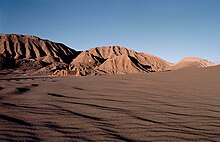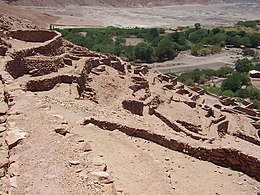Atacama Desert
The Atacama Desert (also called Atacama for short , more rarely Atacama Desert ) extends along the Pacific coast of South America between the 18th and 27th parallel south, i.e. roughly between the cities of Tacna in southern Peru and Copiapo in northern Chile , over a distance of around 1200 kilometers. A distinction is made between three longitudinal zones from west to east: the Cordillera de la Costa , the intermediate valley and the Andes massif .
The Atacama is a coastal desert and the driest desert on earth outside of the polar regions. A hyperarid climate has existed in its central area for at least 15 million years . There are places where no rain has been recorded for decades, with average annual rainfall levels of just 0.5mm. Its southern area between the 24th and 27th parallel has therefore remained completely unpopulated until recently.
climate
The Atacama lies in the rain shadow of the Andes ; Occurring easterly winds are dry and do not bring any precipitation . Close to the coast, a cold ocean current, the Humboldt Current, prevents rain clouds from developing, so that unlike further north or south, no incline rain falls. However, the cold sea water means that the Atacama is cool and fog often prevails, especially near the coast, which is why the Atacama also belongs to the foggy deserts . Due to the effects of the El Niño climatic phenomenon , which is accompanied by the lagging behind of the Humboldt Current, heavy rainfall occurs relatively regularly every six to ten years. These then lead to the desert blooming for a short period of time .
In February 2012, as in the previous year, the heavy rain destroyed roads and caused landslides. In Toconao and Río Grande, for example, houses were washed down and fields destroyed, and residents were cut off from the drinking water supply for weeks.
The annual mean here is only about one fiftieth of the amount of rain that is measured in Death Valley in the USA . There are weather stations in the Atacama that have recorded no rainfall for many years. There are, especially in the intermediate valley, very large differences between the maximum temperatures during the day (30 ° C) and the minimum temperatures at night (−15 ° C).
history
The Atacama Desert is about 15 million years old. Although the Atacama is one of the most arid areas in the world, it was settled relatively early. The Atacameños , Aymara , Diaguitas and Chinchorros peoples settled at the few oases . The latter are best known for their mummified babies, who were buried more than 7,000 years ago. In the 15th century the area became part of the Inca Empire . In 1536 the conquistador Diego de Almagro was the first European to cross the Atacama. After the fall of the Inca rule, the desert came under Spanish rule. The independence efforts of the South American states let the Atacama fall to Bolivia.
The silver deposits discovered in Chañarcillo in 1832 made Chile a major silver producer. During the Saltpeter War (1879–1884), Chile was successful with British support against Peru and Bolivia and was even able to gain new territory in the north. Until then, today's Región de Atacama was the northernmost province of Chile. As a result of the war, Bolivia lost its direct access to the Pacific Ocean - a point of conflict that smoldered between the two states to this day.
In 1916 the exploitation of the copper deposits at Potrerillos began .
In 2003, the Atacama-Humanoid mummy named after the desert was found.
Scientific use
Due to the extremely dry desert climate, several large observatories have been built on the mountains in the desert. The observatories La Silla and Las Campanas are around 50 km south of Vallenar . The European Southern Observatory has built the Paranal Observatory on the Cerro Paranal mountain - 120 km south of the port city of Antofagasta . Other telescopes are the Atacama Large Millimeter Array located on the Chajnantor Plateau and the Atacama Pathfinder Experiment . Furthermore, one of the world's largest telescopes, the ELT, is currently under construction on Cerro Armazones .
The US used the Atacama Desert to test some of their Mars probes .
The mineral atacamite was discovered in this desert in 1801 and named after it.
economy
Today the deposits of lithium , copper, silver, gold and platinum form an economic basis for Chile. The world's largest lithium deposits are believed to be here. In nets, the Atrapanieblas , coastal fog is caught on mountain slopes in the Atacama, which is used to obtain water. Several pilot projects are running in Chile.
A striking landscape element in the Atacama are the numerous salt deserts, such as the Salar de Atacama
People have settled in oases for thousands of years, like here at Pukará de Quitor in San Pedro de Atacama
Lakes in the high plateaus of the Andes, such as Laguna Miscanti , are popular destinations for tens of thousands of tourists every year
The Church of Machuca in San Pedro de Atacama . Here is the first indigenous community that received ownership of their land from the Chilean state over 100 years ago.
Individual evidence
- ↑ Atacama - word meaning.info. Retrieved June 12, 2020 .
- ^ Clarke, Jonathan DA .: Antiquity of aridity in the Chilean Atacama Desert . In: Geomorphology 73.1 . 2006, p. 101-114 ( researchgate.net ).
- ^ Middleton, Nick: Dry as a bone . In: Geographical Magazine 72.4 . 2000, p. 84-85 .
- ^ Pablo A. Marquet, Francisco Bozinovic et al .: Los ecosistemas del Desierto de Atacama y area andina adyacente en el norte de Chile . In: Revista Chilena de Historia Natural . tape 71 , 1998, pp. 593–617 (Spanish, online [PDF; 1.7 MB ; accessed on April 27, 2013]).
- ↑ Calogero M. Santoro, Bernardo T. Arriaza, Vivien G. Standen, Pablo A. Marquet: People of the Coastal Atacama Desert . Living Between Sand Dunes and Waves of the Pacific Ocean. 2005 ( online [PDF; 2.9 MB ; accessed on April 27, 2013]).
literature
- Sir Ranulph Fiennes, Sebastian Junger a. a .: extremes of the earth . In: National Geographic Germany . Hamburg 2004, ISBN 3-936559-31-7 , p. 100 .
Web links
- Margret Karsch: Floods in the Atacama Desert. Portal amerika21.de, April 21, 2012
- Atacama Desert Landscape Photos of the Atacama Desert
- Desierto Florido Photo album on the flora and fauna of the "Desierto Florido" (Spanish)
Coordinates: 22 ° S , 70 ° W







